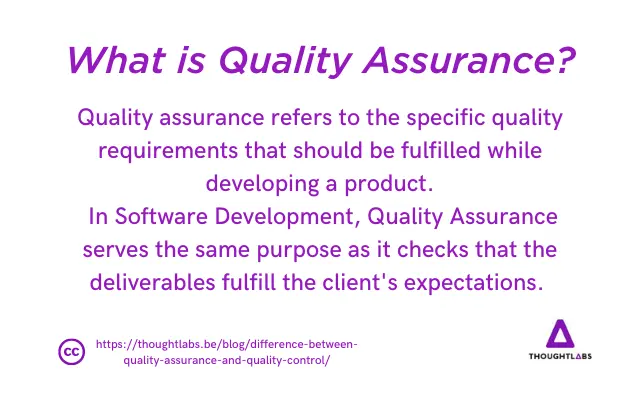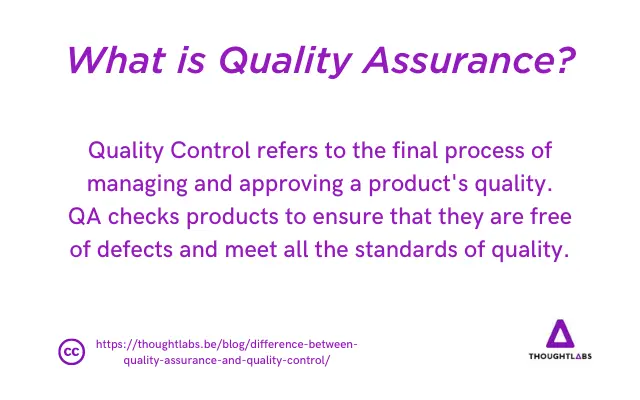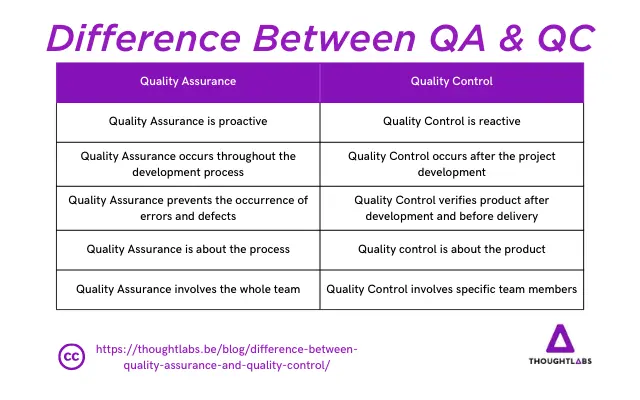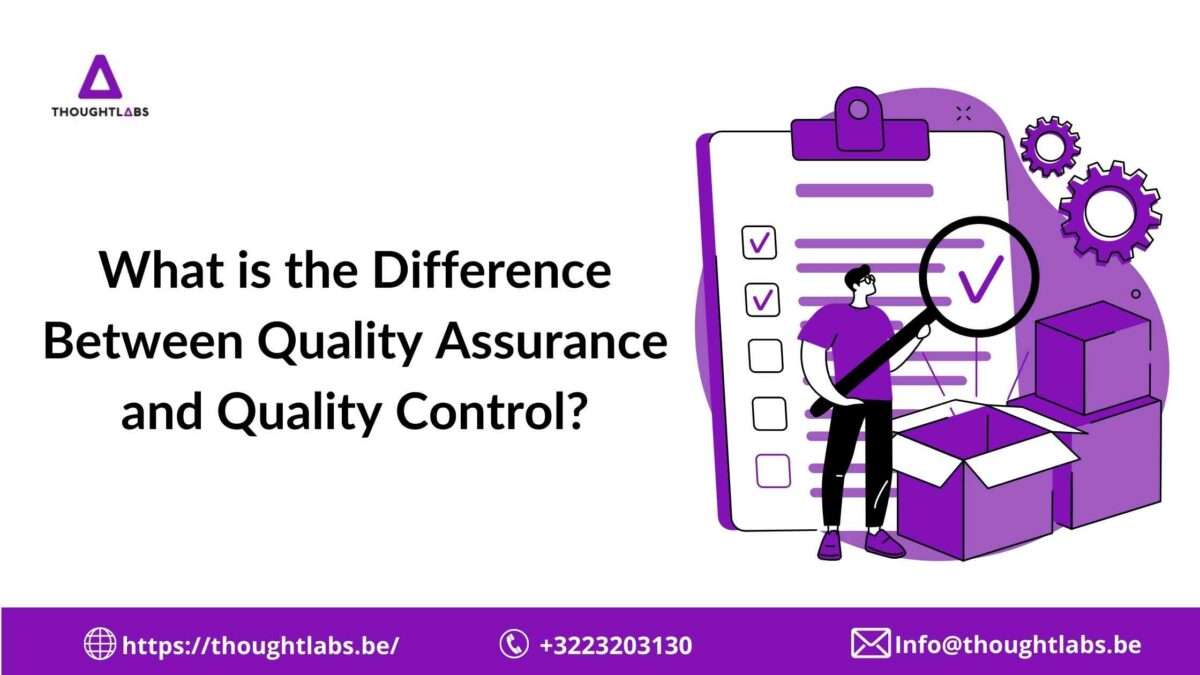Quality Assurance (QA) and Quality Control (QC) are important aspects of the quality management plan of any organization. They ensure that the deliverables are satisfactory, high-quality, and according to the customer’s expectations.
Businesses and organizations must follow both quality assurance and quality control concepts while delivering software or sending products to their customers to meet the quality standards. Understanding and recognizing the importance of QA and QC help organizations achieve their customer’s trust by delivering high-grade products or software that comply with high standards and regulations.
Usually, these terms are used interchangeably however there is a major difference between these two. Let’s learn the difference between Quality Assurance and Quality Control to follow them appropriately.
What is Quality Assurance?
Quality assurance refers to the specific quality requirements that should be fulfilled while developing a product. This is also known as QA testing which ensures that an organization is providing defect-free and high-quality products to customers. However, it is an essential part of an organization’s quality management system to provide a seamless experience to customers.
In Software Development, Quality Assurance serves the same purpose as it checks that the deliverables fulfill the client’s expectations. However, this step must be taken at the start of a certain project to find out the errors and take important steps to eliminate them.

Importance of Quality Assurance (QA)
Quality Assurance is an effective quality management framework that thoroughly checks a certain product or software according to pre-defined regulations and approves them. It is a part of the overall software development process that ensures that the project or services are free of defects and errors while redirecting the procedure to the right side.
QA aims to provide an incredible digital experience to customers while fulfilling their needs in the best possible way. Hence, QA uses a specific set of pre-defined rules, specifications and guidelines to evaluate the quality and accurateness of a product. The process is accomplished by the organization, third parties, and managers while manufacturing a product or developing software.
Quality Assurance Activities and Examples
The most notable activities of QA testing include reviewing, auditing, inspection, functional testing, simulations, standardization, and more. However, QA makes the manufacturing or development process more efficient, smooth, and accurate.
Quality assurance is implemented in a software development process by using PDCA method that includes planning, do, check, and act. Through PDCA, a continuous process is being carried out to improve the standards of a final software product while eliminating errors and bugs.
What is Quality Control (QC)?
Quality Control refers to the final process of managing and approving a product’s quality. It is another important part of a whole quality management system while manufacturing any product or developing software. However, it refers to the fulfillment of quality requirements by inspecting a certain product or software by using operational techniques and procedures.
QA checks products to ensure that they are free of defects and meet all the standards of quality. Also, it quickly detects the errors, bugs, and defects in a product identify them, and provides an accurate solution to resolve them. In general term, Quality Control finally checks and approve the product before delivering it to customers.

Importance of Quality Control
Quality Control plays a major role to deliver error-free and high-grade products to customers while reducing defects and costs. Through QA, all the needs of customers are meet excellently.
It helps to minimize the complaints from customers by delivering top-notch products and software free of errors. Moreover, QA significantly promotes the quality awareness to develop a software or product according to high standards.
Quality Control Activities and Examples
To detect and resolve the issues before delivering, QC activities include inspection, manual testing, automated testing, measurements, validation, and verification.
Difference Between QA and QC
QA and QC are usually confused with each other. However, there is a significant difference between these two aspects of the quality management system. Achieving customer satisfaction through your product success requires to fulfill the QA and QC regulations.
People usually search that what is the difference between Quality Assurance and Quality Control? Although both relate to each other still there are differences between the two. The following points will elaborate on the difference well while allowing you to understand both concepts. Have a look!

Proactive and Reactive
Quality Assurance (QA) is proactive
This means that QA starts with the process of project development establishing a quality management framework to make the products testable while keeping them within scope. Through the proactive approach, the bugs, defects, and errors can be prevented even from the start of the development or manufacturing process so that they never occur throughout the process.
Quality Control (QC) is Reactive
As compared to QA, the Quality Control approach is reactive. However, it is a final quality check process that occurs after the project development to detect the errors and eliminate them before delivering. QA relies on testing and operational techniques to ensure that a product is compliant with the quality and safety measures.
Implementation
QA Occurs Throughout the Development Process
Quality Assurance defines certain rules and regulations of quality assurance for the design, development, and marketing of software or product. However, it occurs from the beginning of project development and follows the whole process to prevent bugs, errors, and defects from occurring. It works as a roadmap to create a certain product as per the pre-defined quality standards and measures.
QC Occurs After the Project Development
QC, on the other hand, occurs after the project development thus before the delivery of the product to customers. It implies a set of operational and testing strategies to confirm that the product fulfills all the quality standards. However, QA identifies any sort of error or defect in a product if any and eliminates it before delivering to meet the client’s expectations.
Roles
QA Prevents the Occurrence of Errors and Defects
QA system is implemented from the very start of project development as its function is to provide a roadmap to reduce errors, defects, and bugs during the process. Hence, it sets certain quality assurance rules and regulations according to which the development process is being carried out to prevent errors while fulfilling the quality standards. This may include standards related to project design, development, marketing, sales, user experience, distribution, and more.
QC Verifies Product after Development
QC includes the operational and testing procedures to verify the product at the final stage after development. Before delivering the project, QA tests a product or software to identify any possible errors or defects and eliminate them. This allow the development team to deliver a high-grade and defect-free product to customers.
Process and Product
Quality Assurance is about Process
QA sets a roadmap for project development that occurs from the start of project development and follows the whole process. However, it ensures that the whole development process follows the pre-defined quality standards to prevent any issues in the future. QA includes process management, documentation, personnel training, and control management.
Quality Control is about Product
The quality control system is applicable to the product after the development so it has nothing to do with the process. QC focuses on the final product to evaluate its quality, identify the possible errors or defects, and reduce them prior to delivery. However, Quality Control includes batch monitoring, testing, inspection, product sampling, and validation.
Team and Individuals
QA Involves the Entire Team
Quality Assurance involves the whole manufacturing and development team. Every team member is equally responsible to accomplish the project development as per the quality standards and regulations. From start to end, all the staff keeps in view the quality measures and standards of operating procedures, designing, development, documentation, and more.
QC Involves Specific Team Members
Quality Control has nothing to do with the whole development team. A specific part of the team fulfills the responsibility of QC after the completion of project development. Their duty involves production inspection, testing, and verification to ensure that they are free of errors and defects before delivering to customers.
Quality Assurance Vs Quality Control
| Quality Assurance (QA) | Quality Control (QA) |
| Quality Assurance is proactive | Quality Control is reactive |
| Quality Assurance occurs throughout the development process | Quality Control occurs after the project development |
| Quality Assurance prevents the occurrence of errors and defects | Quality Control verifies product after development and before delivery |
| Quality Assurance is about the process | Quality control is about the product |
| Quality Assurance involves the whole team | Quality Control involves specific team members |
Bottom Line
The main difference between quality control and quality assurance is that QC focuses on the product itself, while QA looks at the entire process. In order to ensure your product meets customer’s expectations, it’s important to have a system in place for both QC and QA. At www.thoughtlabs.be , all of our products go through QA and QC standards to make sure that desired outcomes are achieved. Reach us today to discuss your project!
